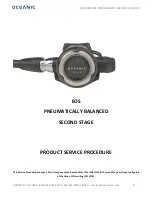
user can increase the absorbance cutoff and get decreased-accuracy nitrate
concentration at higher absorbances.
7.3.4 Description of adaptive sampling
The SUNA V2 has a 256-channel spectrometer that integrates for a specific length of
time, usually 300–500 ms, to maximize the signal while it collects data. When the sensor
makes a measurement, the spectrograph collects UV light for the length of the integration
period. In optically dense waters, with high turbidity or CDOM, very little UV light is
transmitted through the water, so the spectrometer "sees" a much lower signal. The
SUNA V2 automatically increases the integration period to compensate for the low light,
so the sensor has a strong signal in extreme environmental conditions.
7.3.5 Sensor calibration from manufacturer
Sensors come from the manufacturer with a default class-based calibration. Sensors can
have an optional sensor-specific calibration for either fresh water or seawater. The user
can configure a seawater calibration for either fresh water or seawater.
The calibration file is stored in the sensor and includes the coefficients to calculate nitrate,
as well as a reference spectrum. The software has a wizard to let the user update the
reference spectrum at regular intervals or as necessary. This procedure adjusts the
"zero" nitrate value based on a sample of pure water (ultra pure, nano pure, or DI).The
user must periodically update the reference spectrum to make sure that the sensor
collects accurate data because the optical components change over time..
For best performance, send the sensor back to the manufacturer annually for
maintenance.
7.4 Interferences and mitigation
7.4.1 Uncharacterized species in sample
A number of substances in natural water absorb in the UV spectral range where nitrate
absorbs. The spectral signature is usually different from nitrate but certain combinations
of water components may cause a bias in the calculated nitrate concentrations.
If the user thinks there are significant concentrations of interfering species, do a random
spectral and chemical analysis of the water sample to quantify and correct the optical
interference.
7.4.2 Optically dense constituents
The performance of the sensor is compromised in optically dense conditions, which
transmit less light than necessary for the regression analysis. As the optical density
increases, the quality of the measurement (signal-to-noise) decreases. The accuracy and
precision of the nitrate concentration measurements decrease as the quality of the data
decreases. High optical densities are frequently caused by CDOM/turbidity in the water
sample.
7.4.3 Identification of interfering species
The effect of turbidity and CDOM on the measured nitrate concentration was calculated in
the laboratory.
Turbidity sample
NTU per
mg/L
Absorbance at
225 nm (10 mm)
per mg/L
NO
3
change, µM, in
freshwater per mg/L
NO
3
change, µM, in
seawater per mg/L
Arizona Road Dust (ARD)
1.25
0.0016
< -0.002 (-2.8
e
-5)
0.01 (1.4
e
-4)
Kaolin powder
1.5
0.0085
< 0.001 (1.4
e
-5)
0.02 (-2.8
e
-4)
Titanium dioxide (TiO
2
)
15.0
0.0090
< 0.001 (1.4
e
-5)
< 0.001 (1.4
e
-5)
Reference
36
Содержание SUNA V2
Страница 2: ......
Страница 6: ...SUNA quick start guide 4 ...
Страница 14: ...Set up sensor and verify operation 12 ...
Страница 16: ...Deployment and recovery 14 ...
Страница 22: ...Transmit data 20 ...
Страница 42: ...Reference 40 ...
Страница 48: ...Software reference 46 ...
Страница 52: ...General information 50 ...
Страница 53: ......
















































